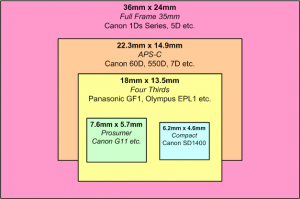It used to be if you had a hair or dust on your film, it was on one picture if it was on the film.
Now, it's most likely on the sensor. That way it shows up on every single picture. Without going into too much detail, if you have a DSLR, you can have your sensor cleaned professionally for about $40.
Or you can try youtube tutorials and try it yourself, which I have done with relatively good success.
There are downfalls to sensors and some definite advantages. I won't go into those, but you can read a technical look at this over here.
But what I really wanted to mention here was about the size of the sensor. A picture is obviously worth a thousand words, esp in this case... check out this image
The camera on the left (D700) has a full size sensor, which is just smaller than a 35mm film negative. The sensor on the left (from a D7000) is a cropped sensor. 1.5X crop as they say.
With a larger sensor, the biggest benefit is more light gathering capacity. And light gathering is what it's all about. I wish I had some more comparisons... I would include the sensors on a point and shoot as well as the other extreme, a medium or large format camera.
Here is a graphic illustration of some of the sizes of sensors

The pink is the full size sensor (of a D700 or D3, etc in Nikons) while the blue and green are point and shoot sensors. The orange is the D90, D80, D300s, D7000, etc)
That is not to say that small sensors don't do a good job, but when lighting becomes more limited, the bigger sensors really "shine".


No comments:
Post a Comment